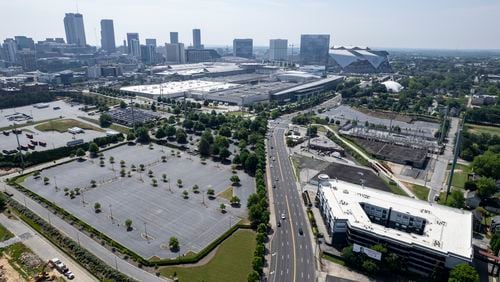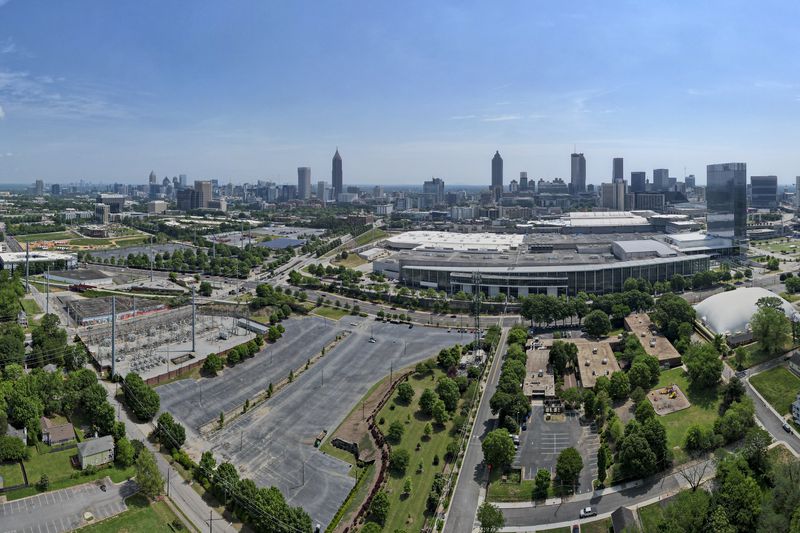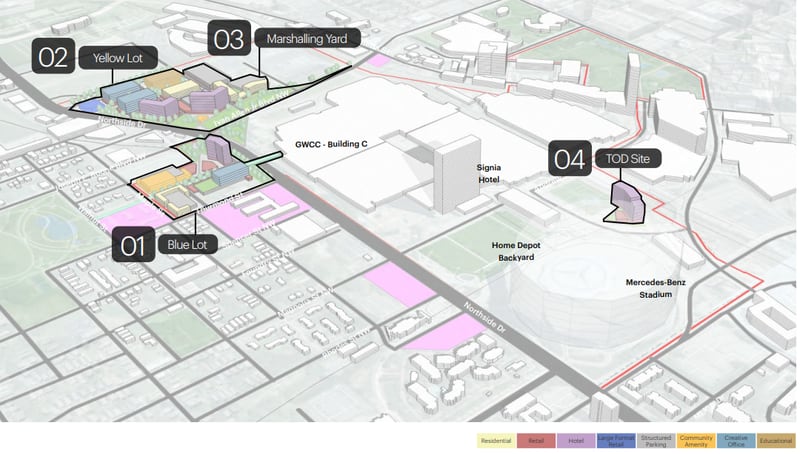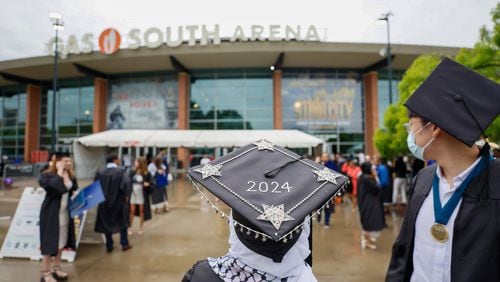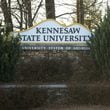Millions of tourists, conventioneers and event-goers are drawn to downtown Atlanta every year, but they often have to cross an ocean of parking lots to reach the city’s island of attractions.
Now one of downtown’s biggest players, the Georgia World Congress Center Authority, is thinking of ways to transform 20 acres of parking lots north and west of its namesake convention center into a live-work-play community.
The state-run authority recently unveiled a new master plan consisting of more than $1 billion in potential projects, including greenspace, mixed-use development and new pedestrian infrastructure.
The plan is still just on paper, and it’s yet to be seen how the developments will be financed. But with a wave of investment and ambitious projects gaining steam across downtown, including Centennial Yards on the doorstep of the convention center, GWCCA Executive Director Frank Poe said he wants to contribute to that momentum.
“We don’t want to be chasing after it,” Poe said of oncoming downtown development. “We want to be part of the conversation and forward-looking with the property we control.”
The authority, which also oversees operations of Centennial Olympic Park, Mercedes-Benz Stadium and the nearby Signia by Hilton hotel, unveiled the early concepts April 30 during its monthly GWCCA board meeting.
Atlanta-based architecture firm HKS found that the Blue Lot west of Northside Drive and the Yellow Lot along Ivan Allen Jr. Boulevard present the greatest development potential.
The plan considers new housing, grocery options and creative offices, while creating connections to the Atlanta Westside Trail and a pedestrian bridge across Northside Drive.
The early-stage vision would likely take years to come to fruition, with Poe saying short-term goals and financing options will be identified by the end of this year. Those would also need to fit in with other major downtown developments, including the $5 billion Centennial Yards project and “Startup City,” a tech-focused redevelopment of 10 blocks in South Downtown.
The authority’s planning would make it one of the most visible downtown development projects and signal the state’s willingness to put its own muscle behind downtown’s revitalization.
The authority is also evaluating a potential mixed-use redo for the former site of the Georgia Dome, now called the Home Depot Backyard.
“Our friends at the GWCCA have been keeping us informed and we are excited about what we are seeing,” said Centennial Yards CEO Brian McGowan. “It’ll be important to coordinate all of this new development so that visitors and residents have a connected, world class experience when they come downtown. Most of all, I see this initiative as another example of continued excitement and momentum for downtown Atlanta.”
A nexus point
The 3.9 million-square-foot Congress Center is one of the largest cogs in downtown’s economic engine. But its development cut off some historically Black westside neighborhoods from downtown and removed others from the map.
The sprawling Congress Center area can also be difficult to navigate by foot, divided by multilane roads.
Credit: Ben Gray
Credit: Ben Gray
Sheba Ross, partner at HKS, said the focus on downtown redevelopment needs to focus on improving the pedestrian experience, especially when large events are not taking place.
“It’s not just about that one Taylor Swift concert,” she said. “It’s about that student who is going be to walking by, coming back from school.”
Still, deck parking is likely to replace a significant portion of the surface lots, along with hotels, offices, residences and retail.
The most recent master plan in 2008 led to development of Mercedes-Benz Stadium and the Signia hotel. Poe said the refreshed master plan turns that attention to edges of the authority’s properties, focusing on the pedestrian experience for people coming to and from Atlanta’s event district.
“This master plan steps outside the four walls of the Congress Center and starts looking at the larger property environment that the authority is responsible for,” Poe said. “Is there a higher use of that property?”
Credit: HKS Inc.
Credit: HKS Inc.
The report maps out potential locations and building heights for new construction at the Blue Lot, Yellow Lot, adjoining marshaling yard and a small site near the GWCC/CNN Center MARTA station. But Ross emphasized that the master plan is meant to be fluid to react to market forces and nearby development progress.
“This is a framework,” she said. “It’s a kit of parts that tests all of these ideas.”
Poe said the authority’s near-term priorities will likely focus on improving the pedestrian experience, which could include the new pedestrian bridge and Beltline connector trail. New construction is difficult to finance currently, with interest rates remaining high and the Federal Reserve indicating rate cuts are still months away.
A.J. Robinson, the president of downtown civic group Central Atlanta Progress, said Atlanta planners for decades prioritized surface parking over residential towers and density. He said that’s beginning to change, with GWCCA having the potential to add fuel to that movement.
“The downtown community is evolving into a more livable environment,” he said. “... Atlanta is kind of maturing as a big city.”
Future of Downtown
This story is part of an occasional series by the AJC to look at the future of Atlanta’s downtown. Several high-profile developments are poised to bring billions of dollars into the city’s core while it continues to grapple with the fallout of the COVID-19 pandemic and a challenging real estate financing market. Downtown will also soon garner international attention when the World Cup comes to Atlanta in 2026, providing a deadline for the city and downtown stakeholders to make promised improvements.
